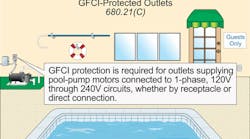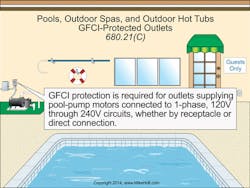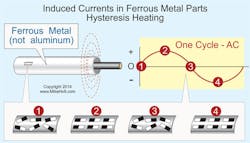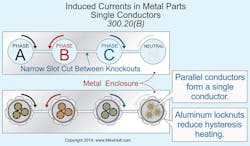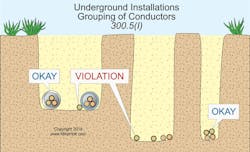Stumped by the Code? NEC Requirements for GFCI Protection of Swimming Pool Pump Motors
All questions and answers are based on the 2014 NEC.
Q. What is the NEC requirement for GFCI protection of swimming pool pump motors?
A. For this question, it’s important to understand the NEC definition of an outlet. An outlet is a point on the wiring system where current is taken to supply utilization equipment [Art. 100]. The outlet can be a point where a receptacle is installed for a cord- and plug-type connection of the pool pump motor. This outlet can also be the point where a pool pump motor is hard wired to the branch circuit. GFCI protection is required for outlets supplying pool pump motors connected to single-phase, 120V power through 240V branch circuits, whether by receptacle or by direct connection [680.21(C)] (Fig. 1). The GFCI protection can be provided by a GFCI receptacle or a GFCI breaker protecting the branch circuit supplying the pool pump motor.
Q. When I parallel conductors, can each phase be routed in a different raceway?
A. To minimize induction heating of ferrous metal raceways and ferrous metal enclosures for AC circuits, and to maintain an effective ground fault current path, all conductors of a circuit must be installed in the same raceway, cable, trench, cord, or cable tray. See Sections 250.102(E), 300.3(B), 300.5(I), and 392.8(D).
When alternating current flows through a conductor, a pulsating or varying magnetic field is created around the conductor. This expanding and collapsing magnetic field induces eddy currents in the ferrous metal parts that surround the conductors, causing the metal parts to heat up from hysteresis heating. Magnetic materials naturally resist the rapidly changing magnetic fields. However, the resulting friction produces its own additional heat — hysteresis heating — in addition to eddy current heating. A metal which offers high resistance is said to have high magnetic “permeability.” Permeability can vary on a scale of 100 to 500 for magnetic materials; nonmagnetic materials have a permeability of one. Simply put, the molecules of steel and iron align to the polarity of the magnetic field. When the magnetic field reverses, the molecules reverse their polarity as well. This back-and-forth alignment of the molecules heats up the metal, and the more the current flows, the greater the heat rises in the ferrous metal parts (Fig. 2).
When conductors of the same circuit are grouped together, the magnetic fields of the different conductors tend to cancel each other out, resulting in a reduced magnetic field around the conductors. The lower magnetic field reduces induced currents in the ferrous metal raceways or enclosures, which reduces the hysteresis heating of the surrounding metal enclosure.
When single conductors are installed in nonmetallic raceways as permitted in Sec. 300.5(I) Exception No. 2, the inductive heating of the metal enclosure must be minimized by the use of aluminum locknuts and by cutting a slot between the individual holes through which the conductors pass [300.20(B)] (Fig. 3). Aluminum conduit, locknuts, and enclosures carry eddy currents, but because aluminum is nonferrous, it doesn’t heat up [300.20(B) Note].
All underground conductors of the same circuit, including the EGC, must be placed inside the same raceway or in close proximity to each other in the same trench [300.5(I)]. See Sec. 300.3(B) (Fig. 4).
Exception No. 1: Conductors can be installed in parallel in raceways, multiconductor cables, or direct-buried single-conductor cables. Each raceway or multiconductor cable must contain all conductors of the same circuit, including the EGC. Each direct-buried single-conductor cable must be located in close proximity in the trench to the other single conductor cables in the same parallel set of conductors, including EGCs.
Exception No. 2: Parallel circuit conductors installed in accordance with Sec. 310.10(H) of the same phase or neutral can be installed in underground PVC conduits, if inductive heating at raceway terminations is reduced by the use of aluminum locknuts and cutting a slot between the individual holes through which the conductors pass as required by Sec. 300.20(B).
Installing ungrounded and neutral conductors in different PVC conduits makes it easier to terminate larger parallel sets of conductors, but it’ll result in higher levels of electromagnetic fields (EMF).
Q. When multiple type NM cables pass through a bored hole in wood framing that will be sealed with foam, am I required to adjust the ampacity of the conductors?
A. Section 334.80 requires that if multiple Type NM cables pass through the same wood framing opening that’s to be sealed with thermal insulation, caulking, or sealing foam, the allowable ampacity of each conductor must be adjusted in accordance with Table 310.15(B)(3)(a).
This requirement has no effect on conductor sizing if you bundle no more than nine current-carrying 14 or 12 AWG conductors together. For example, three 14/2 cables and one 14/3 cable (eight current-carrying 14 THHN conductors) are bundled together in a dry location, the ampacity for each conductor [25A at 90°C, Table 310.15(B)(16)] is adjusted by a 70% adjustment factor [Table 310.15(B)(3)(a)].
• Adjusted Conductor Ampacity = 25A × 0.70
• Adjusted Conductor Ampacity = 17.50A
14 AWG is limited to a 15A overcurrent protection device [240.4(D)]. The 14 AWG conductors with an ampacity of 17.50A after adjustment is okay for the 15A overcurrent protection.
